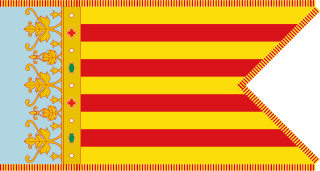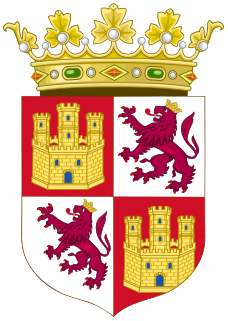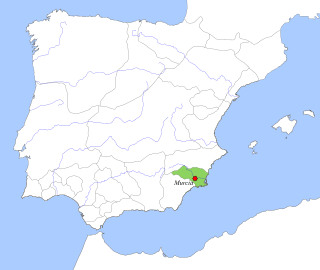
Alfonso the Magnanimous KG was the King of Aragon, Valencia, Majorca, Sardinia and Corsica, Sicily and Count of Barcelona from 1416, and King of Naples from 1442 until his death. He was one of the most prominent figures of the early Renaissance and a knight of the Order of the Dragon.
Year 1244 (MCCXLIV) was a leap year starting on Friday of the Julian calendar.

Alfonso VII, called the Emperor, became the King of Galicia in 1111 and King of León and Castile in 1126. Alfonso, born Alfonso Raimúndez, first used the title Emperor of All Spain, alongside his mother Urraca, once she vested him with the direct rule of Toledo in 1116. Alfonso later held another investiture in 1135 in a grand ceremony reasserting his claims to the imperial title. He was the son of Urraca of León and Raymond of Burgundy, the first of the House of Ivrea to rule in the Iberian peninsula.

Ramon Berenguer IV, sometimes called the Saint, was the Count of Barcelona who brought about the union of his County of Barcelona with the Kingdom of Aragon to form the Crown of Aragon.

The Kingdom of Navarre, originally the Kingdom of Pamplona, was a Basque-based kingdom that occupied lands on either side of the western Pyrenees, alongside the Atlantic Ocean between present-day Spain and France.

The Kingdom of Castile was a large and powerful state located on the Iberian Peninsula during the Middle Ages. Its name comes from the host of castles constructed in the region. It began in the 9th century as the County of Castile, an eastern frontier lordship of the Kingdom of León. During the 10th century its counts increased their autonomy, but it was not until 1065 that it was separated from León and became a kingdom in its own right. Between 1072 and 1157 it was again united with León, and after 1230 this union became permanent. Throughout this period the Castilian kings made extensive conquests in southern Iberia at the expense of the Islamic principalities. Castile and León, with their southern acquisitions, came to be known collectively as the Crown of Castile, a term that also came to encompass overseas expansion.

Sancho Garcés VI, called the Wise was King of Navarre from 1150 until his death in 1194. He was the first monarch to officially drop the title of King of Pamplona in favour of King of Navarre, thus changing the designation of his kingdom. Sancho Garcés was responsible for bringing his kingdom into the political orbit of Europe. He was the eldest son of García Ramírez, the Restorer and Margaret of L'Aigle.

García Ramírez, sometimes García IV, V, VI or VII, called the Restorer, was the King of Navarre (Pamplona) from 1134. The election of García Ramírez restored the independence of the Basque kingdom after 58 years of political union with the Kingdom of Aragon. After some initial conflict he would align himself with king Alfonso VII of León and Castile, and as his ally take part in the Reconquista.

The Kingdom of Valencia, located in the eastern shore of the Iberian Peninsula, was one of the component realms of the Crown of Aragon. When the Crown of Aragon merged by dynastic union with the Crown of Castile to form the Kingdom of Spain, the Kingdom of Valencia became a component realm of the Spanish monarchy.

The House of Trastámara was a dynasty of kings in Spain, which first governed in Castile beginning in 1369 before expanding its rule into Aragon, Navarre and Naples. They were an illegitimate cadet line of the House of Ivrea.

The Crown of Castile was a medieval state in the Iberian Peninsula that formed in 1230 as a result of the third and definitive union of the crowns and, some decades later, the parliaments of the kingdoms of Castile and León upon the accession of the then Castilian king, Ferdinand III, to the vacant Leonese throne. It continued to exist as a separate entity after the personal union in 1469 of the crowns of Castile and Aragon with the marriage of the Catholic Monarchs up to the promulgation of the Nueva Planta decrees by Philip V in 1715.

The Treaty of Almizra was the third of a series of three treaties between the Crown of Aragon and Crown of Castile meant to determine the limits of their expansion into Andalusia so as to prevent squabbling between the Christian princes. Specifically, it defined the borders of the Kingdom of Valencia. James I of Aragon signed it on 26 March 1244, but Alfonso X of Castile did not affirm it until much later. According to the treaty, all lands south of a line from Biar to Villajoyosa through Busot were reserved for Castile.

Tibi is a municipality in the comarca of Alcoià, Alicante, Valencia, Spain. The name of this municipality comes from latin and it means "for you". This territory was populated with 1,564 people in the year 2018.

Ferdinand II, called the Catholic, was King of Aragon from 1479 until his death. His marriage in 1469 to Isabella, the future queen of Castile, was the marital and political "cornerstone in the foundation of the Spanish monarchy." As a consequence of his marriage to Isabella I, he was de jure uxoris King of Castile as Ferdinand V from 1474 until her death in 1504. At Isabella's death the crown of Castile passed to their daughter Joanna, by the terms of their prenuptial agreement and her last will and testament. Following the death of Joanna's husband Philip I of Spain, and her alleged mental illness, Ferdinand was recognized as regent of Castile from 1508 until his own death. In 1504, after a war with France, he became King of Naples as Ferdinand III, reuniting Naples with Sicily permanently and for the first time since 1458. In 1512, he became King of Navarre by conquest. In 1506 he married Germaine of Foix of France, but Ferdinand's only son and child of that marriage died soon after birth; had the child survived, the personal union of the crowns of Aragon and Castile would have ceased.
The Treaty of Sahagún ended a state of war between the Castile and León, establishing pacem et ueram amiciciam between their respective monarchs, Sancho III and Ferdinand II, who called themselves boni fratres et boni amici. It was signed at the monastery of Sahagún on 23 May 1158.

The Taifa of Murcia was an Arab taifa of medieval Al-Andalus, in what is now southern Spain. It became independent as a taifa centered on the Moorish city of Murcia after the fall of the Umayyad Caliphate of Córdoba. Moorish Taifa of Murcia included Albacete and part of Almería as well.

The Mudéjar revolt of 1264–1266 was a Mudéjar rebellion in the Lower Andalusia and Murcia regions of the Crown of Castile. The rebellion was in response to Castile's policy of relocating Muslim populations from these regions and was partially instigated by Muhammad I of Granada. The rebels were aided by the independent Emirate of Granada, while the Castilians were allied with Aragon. Early in the uprising, the rebels managed to capture Murcia and Jerez, as well as several smaller towns, but were eventually defeated by the royal forces. Subsequently, Castile expelled the Muslim populations of the reconquered territories and encouraged Christians from elsewhere to settle their lands. Granada became a vassal of Castile and paid an annual tribute.

















